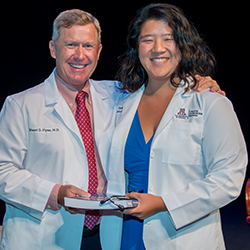The Significance of the White Coat
It’s July again in Phoenix. For most, this signals our yearly retreat into the great indoors, as the 110-degree weather scorches the earth and melts our tires to the asphalt. For the University of Arizona College of Medicine – Phoenix, however, this is a special time of year, as we give a very warm welcome to our latest class of first-year medical students.
 On Friday, the Class of 2021 will receive their white coats, a rite of passage for which they have spent countless hours studying, volunteering, researching, applying, interviewing and hoping to achieve. Nowadays, the ceremony is seen as an integral part of every medical school, but many would be surprised to learn that it has only existed for a few decades. What is the significance of the White Coat Ceremony, then, and where did it come from?
On Friday, the Class of 2021 will receive their white coats, a rite of passage for which they have spent countless hours studying, volunteering, researching, applying, interviewing and hoping to achieve. Nowadays, the ceremony is seen as an integral part of every medical school, but many would be surprised to learn that it has only existed for a few decades. What is the significance of the White Coat Ceremony, then, and where did it come from?
Through the late 19th century, Western physicians usually dressed in black formal attire to reflect the seriousness of their interactions with patients. As science progressed, along with a better understanding of hygiene, the white laboratory coat was gradually adopted to represent scientific rigor and cleanliness. Today, it is widely worn by those who work in medicine and scientific research.
Now that my class has reached our fourth year, I have to admit that our own White Coat Ceremony feels like it happened a lifetime ago. I remember that we were all eager to finally don our white coats and to start feeling like medical students. As the years passed, some began to feel as if the coat were a burden — a flag signaling that we know nothing on the wards, an impossible laundry item with permanent stains, an unnecessary layer in the Phoenix summer.
Looking back, however, there have been practical benefits to wearing a white coat. If someone forgets your name, they can just read it off of your coat without having to awkwardly ask you again. If you are a woman, no one will automatically assume you are the nurse. Although it is hot outside, it is always cold inside the hospital, so the extra layer comes in handy. And the pockets are great for holding notes and, most importantly, snacks for those shifts when you do not have time to grab a meal.
The perception of the white coat has similarly varied amongst physicians and patients alike. Some see it as an honor, while others see it as a symbol of elitism. And while many patients prefer that their health care provider wears professional dress with a white coat, these opinions vary with age — with younger patients often preferring less formal attire. These divergent attitudes may lead us to question the place of the white coat in modern medicine.
Perhaps, then, it is the role of ceremony to clarify the symbolism of the coat and to instill in medical students the weight of responsibility it confers. The first White Coat Ceremony was held by Pritzker School of Medicine at the University of Chicago in 1989, an idea that was then adapted into the first “full-fledged” White Coat Ceremony sponsored by the Arnold P. Gold Foundation and Columbia University College of Physicians and Surgeons in 1993. By the turn of the millennium, the ceremony had been adopted by the vast majority of medical schools in the country. As with any other uniform, the white coat can be seen as just an article of clothing associated with a particular job. The motivation behind the White Coat Ceremony, however, was to emphasize compassion in medicine at the very beginning of medical training, not just at graduation when students become doctors, and to link this idea of patient-centered humanism to the coat we would be expected to wear. The white coat also connects us to everyone else who shares this profession, and the ceremony, in particular, offers us an opportunity to reflect on why we have chosen this path and what we hope to accomplish while wearing it.
As I face my last year with a short white coat, I realize all the moments associated with it. I can picture it with me throughout my time here: Doctoring sessions, Capstones, CHIP events, CCE, third-year clerkships, Step 2CS and now fourth-year. In it, I have examined more patients than I can remember, have sprinted down corridors and stairwells, have trudged around in post-call delirium and have enjoyed second desserts in our hospital cafeterias. I see it hugging the backs of chairs in dozens of resident rooms, and I see it amongst a sea of white and off-white coats hanging outside the ORs. It will always be woven into my memories of medical school and everything that I have learned these short few years, and for that, I will always be grateful.
And so, to our newest cohort of schoolmates, I congratulate you on your achievements. Whether you come to cherish your coat or not, it will always be there to represent your place in the medical world and the journey you will now begin. So when you wear your white coat, wear it proudly — and always carry a protein bar in one of the pockets.
Sophie B. Sun
MD Candidate, Class of 2018
UA College of Medicine – Phoenix
About the College
Founded in 2007, the University of Arizona College of Medicine – Phoenix inspires and trains exemplary physicians, scientists and leaders to optimize health and health care in Arizona and beyond. By cultivating collaborative research locally and globally, the college accelerates discovery in a number of critical areas — including cancer, stroke, traumatic brain injury and cardiovascular disease. Championed as a student-centric campus, the college has graduated more than 800 physicians, all of whom received exceptional training from nine clinical partners and more than 2,700 diverse faculty members. As the anchor to the Phoenix Bioscience Core, which is projected to have an economic impact of $3.1 billion by 2025, the college prides itself on engaging with the community, fostering education, inclusion, access and advocacy.


